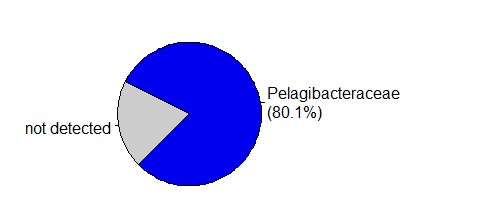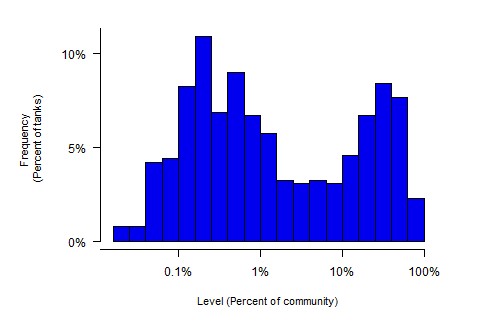The Family Pelagibacteraceae
The family Pelagibacteraceae (also known as the SAR11 clade) is a group of aerobic, free-living, chemoheterotrophic bacteria found throughout the marine environment. These are oligotrophic bacteria that grow best in relatively low-nutrient conditions like those found in the open ocean and on offshore coral reefs. These are thought to be the most abundant group of bacteria in the global ocean.
These bacteria have specific nutritional requirements for several nutrients produced in surface waters by phytoplankton or photooxidation of dissolved organic matter. These include the amino acids methionine or glycine, and the organic acid pyruvate, or precursors for these (including betaine glycine, glycolate and oxaloacetate).
We consider high levels of Pelagibacteraceae to be a positive finding. In part because they are the most abundant group on natural reefs. This group also serves as a useful marker for microbiome maturity, because it takes some time during the establishment of a new tank before this family rises to dominance.
Pelagibacteraceae on coral reefs
Apart from Cyanobacteria, the Pelagibacteria are consistently the most abundant group in water samples from natural coral reefs. Their levels are highest in offshore reefs exposed to water from the open ocean. A survey of reef habitats on the Great Barrier Reef found that their levels were highest in waters with the highest levels of dissolved organic carbon (DOC).
The Pelagibacteraceae are found at higher levels in reefs with higher levels of coral cover, and lower levels in algae-dominated habitats.
Growth experiments have shown that growth of these bacteria is not promoted by either algal or coral nutrients, they actually grew better on seawater controls than in seawater enriched with nutrients exuded from corals or algae.
Pelagibacteraceae in reef tanks

Bacteria from the family Pelagibacteraceae are present in most reef tank samples.

The levels of this family vary widely across samples. There are generally two groups of tanks: in some, this group makes up 10-80% of the community. In other, they make up <1% of the community. This generally reflects the use of UV in some tanks, which specifically removes this group from the community.

The Pelagibacteraceae are true bacterioplankton. These free-living Bacteria are found primarily in the water community, with much lower levels in biofilm samples.
Read more
Wikipedia: Pelagibacteraceae, see also Pelagibacterales
MicrobeWiki: Pelagibacterales
Adjusting your Pelagibacteraceae levels
-
Increasing your levels
-
Turn off UV sterilizer
-
Change water to reduce nutrients that promote other families which outcompete Pelagibacteraceae
-
Decreasing your levels
-
Turn on UV sterilizer
-
Increase nutrient levels (increased feeding or decreased export) to promote competing groups
Testing your tank for Pelagibacteraceae
Our standard Microbiome Test includes information on the levels of Pelagibacteraceae in your tank. This family is the best marker for maturity of the aquarium microbiome. Does your community look like a mature tank or a new tank? Test your tank today and find out!
